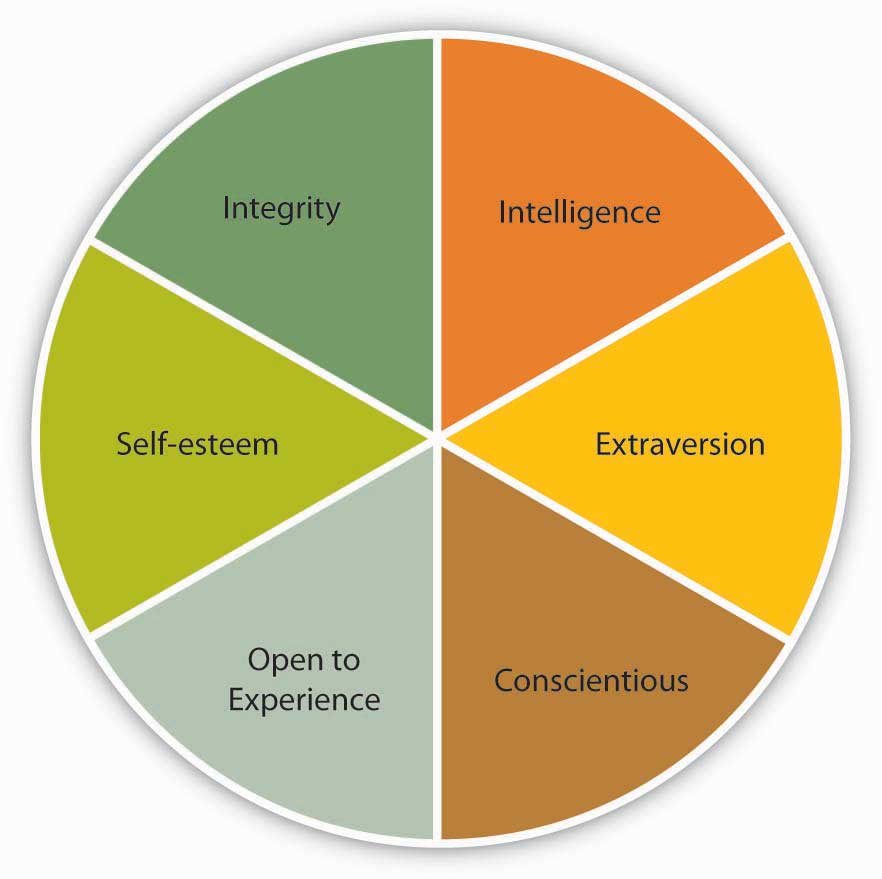Personality and Leadership a Qualitative and Quantitative Review
10.two Who Is a Leader? Trait Approaches to Leadership
Learning Objectives
- Larn the position of trait approaches in the history of leadership studies.
- Explain the traits that are associated with leadership.
- Hash out the limitations of trait approaches to leadership.
The primeval arroyo to the report of leadership sought to place a set up of traits that distinguished leaders from nonleaders. What were the personality characteristics and physical and psychological attributes of people who are viewed every bit leaders? Because of the problems in measurement of personality traits at the fourth dimension, dissimilar studies used different measures. By 1940, researchers concluded that the search for leadership-defining traits was futile. In contempo years, though, after advances in personality literature such as the development of the Large Five personality framework, researchers take had more success in identifying traits that predict leadership.Firm, R. J., & Aditya, R. N. (1997). The social scientific written report of leadership: Quo Vadis? Journal of Management, 23, 409–473. Most importantly, charismatic leadership, which is amid the contemporary approaches to leadership, may be viewed as an case of a trait approach.
The traits that testify relatively stiff relations with leadership are as follows:Judge, T. A., Bono, J. E., Ilies, R., & Gerhardt, 1000. W. (2002). Personality and leadership: A qualitative and quantitative review. Journal of Applied Psychology, 87, 765–780.
Intelligence
Full general mental ability, which psychologists refer to as "yard" and which is often called IQ in everyday language, has been related to a person'due south emerging every bit a leader within a group. Specifically, people who have high mental abilities are more likely to be viewed as leaders in their environment.House, R. J., & Aditya, R. N. (1997). The social scientific study of leadership: Quo Vadis? Journal of Management, 23, 409–473; Ilies, R., Gerhardt, K. W., & Huy, 50. (2004). Individual differences in leadership emergence: Integrating meta-analytic findings and behavioral genetics estimates. International Journal of Selection and Assessment, 12, 207–219; Lord, R. G., De Vader, C. L., & Alliger, G. M. (1986). A meta-assay of the relation between personality traits and leadership perceptions: An application of validity generalization procedures. Journal of Applied Psychology, 71, 402–410; Taggar, Due south., Hackett, R., & Saha, S. (1999). Leadership emergence in autonomous piece of work teams: Antecedents and outcomes. Personnel Psychology, 52, 899–926. We should caution, though, that intelligence is a positive but modest predictor of leadership. In add-on to having high IQ, constructive leaders tend to have high emotional intelligence (EQ). People with high EQ demonstrate a loftier level of self-awareness, motivation, empathy, and social skills. The psychologist who coined the term emotional intelligence, Daniel Goleman, believes that IQ is a threshold quality: it matters for entry- to loftier-level management jobs, but one time y'all get there, it no longer helps leaders because virtually leaders already have high IQ. According to Goleman, what differentiates effective leaders from ineffective ones becomes their power to command their own emotions and empathize other people's emotions, their internal motivation, and their social skills.Goleman, D. (2004, January). What makes a leader? Harvard Business Review, 82(1), 82–91. Many observers believe that Carly Fiorina, the ousted CEO of HP, demonstrated high levels of intelligence but low levels of empathy for the people around her, which led to an overreliance on numbers while ignoring the human price of her decisions.Karlgaard, R. (2/18/2002). Vote Carly, Forbes, 169(4), 37.
Effigy 10.four Big Five Personality Traits

Source: Goldberg, L. R. (1990). An alternative "description of personality": The big-five gene structure. Journal of Personality & Social Psychology, 59, 1216–1229.
Psychologists accept proposed various systems for categorizing the characteristics that make upwardly an private's unique personality; one of the most widely accepted is the Big Five model, which rates an individual according to openness to experience, conscientiousness, extraversion, agreeableness, and Neuroticism. Several of the Big 5 personality traits have been related to leadership emergence (whether someone is viewed as a leader by others) and leadership effectiveness.
Figure 10.v

Steve Ballmer, CEO of Microsoft, is an extraverted leader. For example, to celebrate Microsoft's 25th anniversary, Ballmer enthusiastically popped out of the anniversary cake to surprise the audience.
For instance, extraversion is related to leadership. extraverts are sociable, assertive, and energetic people. They enjoy interacting with others in their environment and demonstrate self-confidence. Because they are both dominant and sociable in their environment, they sally every bit leaders in a broad multifariousness of situations. Out of all personality traits, extraversion has the strongest human relationship to both leader emergence and leader effectiveness. Research shows that conscientious people are also more likely to be leaders. This is not to say that all effective leaders are extraverts, just you are more likely to notice extraverts in leadership positions. An example of an introverted leader is Jim Buckmaster, the CEO of Craigslist. He is known as an introvert, and he admits to not having meetings because he does non like them.Buckmaster, Jim. (2008, May). How does he manage? Classified Spider web site boss. Direction Today, fifteen.
Some other personality trait related to leadership is conscientiousness. Careful people are organized, have initiative, and demonstrate persistence in their endeavors. Careful people are more likely to emerge as leaders and be effective as leaders. Finally, people who take openness to experience—those who demonstrate originality, creativity, and are open to trying new things—tend to emerge as leaders and tend to exist effective as leaders.
Self-Esteem
Cocky-esteem is not one of the Big 5 personality traits, but it is an important aspect of one's personality. The degree to which people are at peace with themselves and have an overall positive assessment of their self-worth and capabilities seems to be relevant to whether they will be viewed as a leader. Leaders with high cocky-esteem support their subordinates more than, and when punishment needs to be administered, they punish more finer.Atwater, L. E., Dionne, S. D., Camobreco, J. F., Avolio, B. J., & Lau, A. (1998). Individual attributes and leadership style: Predicting the apply of penalisation and its effects. Periodical of Organizational Behavior, xix, 559–576; Niebuhr, R. E., & Davis, K. R. (1984). Cocky-esteem: Human relationship with leader beliefs perceptions as moderated by the duration of the superior-subordinate dyad association, Personality and Social Psychology Buletin, 10, 51–59. It is possible that those with high cocky-esteem have greater levels of self-confidence and this affects their paradigm in the eyes of their followers. Cocky-esteem may also explain the human relationship between some physical attributes and emerging every bit a leader. For example, enquiry shows a strong relationship between height and being viewed as a leader (besides as one's career success over life). Information technology is proposed that self-esteem may be the key to the connection of pinnacle with leadership, considering people who are taller are also plant to have higher self-esteem and therefore may project greater levels of charisma as well as confidence to their followers.Estimate, T. A., & Cable, D. M. (2004). The event of physical height on workplace success and income: Preliminary test of a theoretical model. Journal of Practical Psychology, 89, 428–441.
Integrity
Effigy ten.6 Traits Associated with Leadership

Research also shows that people who are effective as leaders tend to accept a moral compass and demonstrate honesty and integrity.Reave, L. (2005). Spiritual values and practices related to leadership effectiveness. Leadership Quarterly, 16, 655–687. Leaders whose integrity is questioned lose their trustworthiness, and they hurt their visitor'southward business organization along the fashion. For example, when it was revealed that Whole Foods CEO John Mackey was using a pseudonym to brand negative comments online virtually the company's rival Wild Oats, his actions were heavily criticized, his leadership was questioned, and the company's reputation was affected.Farrell, Thousand., & Davidson, P. (2007, July thirteen). Whole Foods' CEO was decorated guy online. USA Today, Section: Money, 04B.
Figure ten.seven

Condoleezza Rice had dissimilar responsibilities as the provost of Stanford University compared with her part as secretary of state for the United States. Do yous think these differences affected her behavior equally a leader?
There are as well some traits that are negatively related to emerging equally a leader and being successful as a leader. For example, agreeable people who are modest, good natured, and avert conflict are less likely to be perceived as leaders.Judge, T. A., Bono, J. E., Ilies, R., & Gerhardt, M. Due west. (2002). Personality and leadership: A qualitative and quantitative review. Periodical of Applied Psychology, 87, 765–780. The primal to benefiting from the findings of trait researchers is to be aware that non all traits are equally effective in predicting leadership potential across all circumstances. Some organizational situations let leader traits to make a greater difference.House, R. J., & Aditya, R. N. (1997). The social scientific written report of leadership: Quo Vadis? Periodical of Management, 23, 409–473. For example, in small, entrepreneurial organizations where leaders have a lot of leeway to determine their own behavior, the type of traits leaders have may make a difference in leadership potential. In large, bureaucratic, and rule-bound organizations, such as the authorities and the military machine, a leader'due south traits may have less to do with how the person behaves and whether the person is a successful leader.Gauge, T. A., Bono, J. E., Ilies, R., & Gerhardt, M. Westward. (2002). Personality and leadership: A qualitative and quantitative review. Journal of Applied Psychology, 87, 765–780. Moreover, some traits become relevant in specific circumstances. For example, bravery is likely to be a key feature in military leaders but non necessarily in business leaders. Scholars now conclude that instead of trying to place a few traits that distinguish leaders from nonleaders, it is important to place the conditions under which different traits affect a leader'due south operation, also equally whether a person emerges equally a leader.Hackman, J. R., & Wageman, R. (2007). Asking the right questions nigh leadership: Discussion and conclusions. American Psychologist, 62, 43–47.
Key Takeaway
Many studies searched for a limited fix of personal attributes, or traits, which would make someone be viewed as a leader and be successful equally a leader. Some traits are consistently related to leadership, such equally intelligence (both mental ability and emotional intelligence), personality (extraversion, conscientiousness, openness to experience, self-esteem), and integrity. The master limitation of the trait approach was that it ignored the state of affairs in which leadership occurred. Therefore, information technology is more useful to specify the atmospheric condition nether which different traits are needed.
Exercises
- Recall of a leader you admire. What traits does this person accept? Are they consistent with the traits discussed in this affiliate? If not, why is this person effective despite the presence of different traits?
- Tin the findings of trait approaches exist used to train potential leaders? Which traits seem easier to teach? Which are more stable?
- How can organizations identify future leaders with a given set of traits? Which methods would exist useful for this purpose?
- What other traits can yous retrieve of that would exist relevant to leadership?
Source: https://saylordotorg.github.io/text_principles-of-management-v1.1/s14-02-who-is-a-leader-trait-approach.html
Mag-post ng isang Komento for "Personality and Leadership a Qualitative and Quantitative Review"